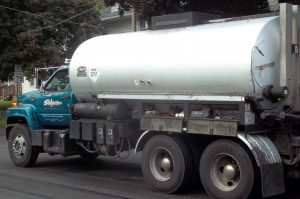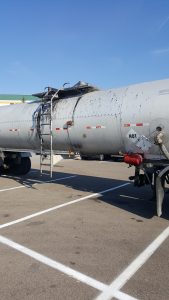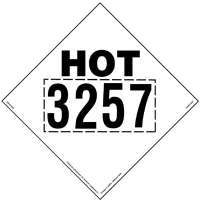This question came through my website May 2, 2016 from someone I’ve never done business with prior to – or since – this contact:
To Whom It May Concern,
I saw a recent post you made on your web site regarding elevated temperature materials, a requirements for labeling requirements.
Can you answer the following question for me?
Does the transportation of liquid asphalt, if shipped above 212 degrees F, as an elevated temperature material, require the use of 4-digit identification number on shipping documents, placards, or panels as named in part 11 Section 172.101, Publication BOE 6000?
Any advice or guidance would be greatly appreciated.
My reply on May 2nd, to buy myself some time:
I will research the information and get back to you with an answer this week.
And then, on May 7, 2016:
I will attempt to answer your question below.
- Is in a liquid phase and at a temperature at or above 100 °C (212 °F);
- Is in a liquid phase with a flash point at or above 38 °C (100 °F) that is intentionally heated and offered for transportation or transported at or above its flash point;or,
- Is in a solid phase and at a temperature at or above 240 °C (464 °F).
What you describe appears to be an Elevated Temperature Material. If that is the case, then it must be shipped as a fully regulated hazardous material which includes but is not limited to:
- Shipping papers, including the additional description (see below).
- Placards will not be required if the HazMat is solely a Class 9 Miscellaneous. Why not? Class 9 Placards are not required within the U.S.
- Labels are not required on a bulk packaging.
- The following package markings:
- The HazMat’s 4-digit identification number (UN3257) on two opposing sides of a bulk packaging with a capacity of <1,000 gallons or on all four sides of a bulk packaging with a capacity of ≥1,000 gallons. The identification number must be displayed on all four sides of a cargo tank or tank car.
- “HOT” must be displayed on two opposing sides of any bulk packaging.
- What is an Elevated Temperature Material?
- Additional Description Requirement on HazMat Shipping Paper.
- What is a Bulk Packaging?
 I thought that might be it, but a few days later (5.09.16) he replied with more questions:
I thought that might be it, but a few days later (5.09.16) he replied with more questions:
- Placards will not be required if the HazMat is solely a Class 9 Miscellaneous. Why not? Class 9 Placards are not required within the U.S.
- Labels are not required on a bulk packaging.
§ 172.325 Elevated temperature materials.
(a) Except as provided in paragraph (b) of this section, a bulk packaging containing an elevated temperature material must be marked on two opposing sides with the word “HOT” in black or white Gothic lettering on a contrasting background. The marking must be displayed on the packaging itself or in black lettering on a plain white square-on-point configuration having the same outside dimensions as a placard. (See § 172.302(b) for size of markings on bulk packagings.)(b) Bulk packagings containing molten aluminum or molten sulfur must be marked “MOLTEN ALUMINUM” or “MOLTEN SULFUR”, respectively, in the same manner as prescribed in paragraph (a) of this section.(c) If the identification number is displayed on a white-square-on-point display configuration, as prescribed in § 172.336(b), the word “HOT” may be displayed in the upper corner of the same white-square-on-point display configuration. The word “HOT” must be in black letters having a height of at least 50 mm (2.0 inches). Except for size, these markings shall be as illustrated for an Elevated temperature material, liquid, n.o.s.:
Like this article? Subscribe to my Monthly Newsletter No marketing emails! |
I didn’t mind his challenge. It caused me to think deeper about the regulations before I replied that same day:
I agree with the regulatory citation you indicated but not the conclusion you draw. In your previous email you state:
The language is pretty clear that while “a bulk packaging must be marked with the appropriate identification number on class 9 placard” it continues on further to say “OR a white square-on-point display” indicating that either can be used, and if a white square-on-point display is used then there is no 4 digit identifier is required.
My interpretation of the Hazardous Material Regulations you reference is this:
- The regulations require a bulk package of a HazMat to be marked with the identification number. Indeed, all HazMat packages must be marked with the identification number unless an exception to the Hazardous Material Regulations applies.
- The identification number may be displayed on a placard, or an orange panel, or a white square-on-point.
- If the white square-on-point is used the word “HOT” may be included in the upper corner if the HazMat is also an Elevated Temperature Material.
- It does not say that the display of the identification number on the white square-on-point is a replacement for the “HOT” marking or vice versa.
 Clearly this issue was important to him and he had given it a lot of thought (5.09.16):
Clearly this issue was important to him and he had given it a lot of thought (5.09.16):
Dan,
Our exchanges got shorter as we refined our arguments (5.10.16):
You are correct. The “or”, however, pertains to the options for how to display the identification number not if you display the identification number. Display of the ID # is not optional.
Please let me know your opinion on this.
May 10, 2016, Finally my answer satisfied him!
Thanks for clarifying! That helps.
Contact me with any questions you may have about the transportation of hazardous materials by air, highway, vessel, or rail International and Domestic Daniels Training Services 815.821.1550 |
I was glad to help and couldn’t resist a shameless plug:
No problem. Glad I could help. Please let me know if I can answer any other questions you may have.
Or if you require any training.



